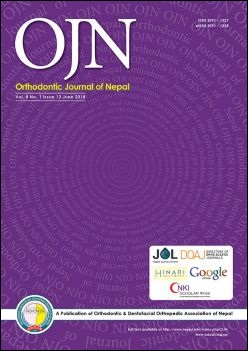Prevalence of Malocclusion and Evaluation of Orthodontic Treatment Need amongst Patients in Pokhara, Nepal
DOI:
https://doi.org/10.3126/ojn.v8i1.21335Keywords:
Dental Health Component, Index of Orthodontic Treatment Need, malocclusionAbstract
Introduction: Prevalence of malocclusion and orthodontic treatment need varies according to different region based on ethnic diversity.
Objective: To assess the prevalence of malocclusion and orthodontic treatment need amongst patients visiting College of Dental Surgery, Gandaki Medical College, Pokhara, Nepal.
Materials & Method: A cross-sectional study based on WHO-Oral Health Survey Basic Methods using Community Periodontal Index (CPI) probe and mouth mirror was conducted. The malocclusion based on Angle’s classification, overjet, overbite, open bite, crowding, spacing and cross bites were recorded. Dental Health Components (DHC) of Index of Orthodontic Treatment Need (IOTN) was recorded. The frequency distribution was calculated and chi square test was used to assess the gender difference.
Result: The prevalence of normal occlusion was 5.8%, Angle’s Class I malocclusion was 67.9%, Class II was 19.5% and Class III was 6.8%. Crowding (51.07%) was more common malocclusion trait than spacing (24.46%). There were no significant differences in distribution of various occlusal traits between male and female subjects. Orthodontic treatment need based on DHC showed: 19.40% were in definite/extreme need of treatment (Grade 4/5), 21.93% had borderline need (Grade 3) and 58.67% had no/ little need of treatment (Grade 1/2).
Conclusion: Angle’s Class I was the most common malocclusion trait (67.9%) followed by anterior crowding (51.07%). 19.40% patients visiting the teaching hospital in Pokhara are in definite or extreme need of orthodontic treatment
Downloads
Downloads
Published
How to Cite
Issue
Section
License
Copyright © held by Orthodontic & Dentofacial Orthopedic Association of Nepal
- Copyright on any research article is transferred in full to the Orthodontic & Dentofacial Orthopedic Association of Nepal upon publication in the journal. The copyright transfer includes the right to reproduce and distribute the article in any form of reproduction (printing, electronic media or any other form).
- Articles in the Orthodontic Journal of Nepal are Open Access articles published under the Creative Commons CC BY License (https://creativecommons.org/licenses/by/4.0/)
- This license permits use, distribution and reproduction in any medium, provided the original work is properly cited.




